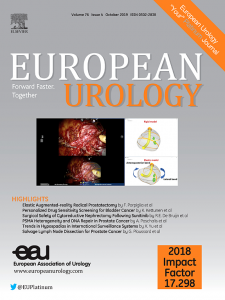Magnetic Resonance Imaging–based Biopsy Strategies in Prostate Cancer Screening: A Systematic Review
IF 25.3
1区 医学
Q1 UROLOGY & NEPHROLOGY
引用次数: 0
Abstract
Background and objective
Prostate cancer (PCa) screening using prostate-specific antigen (PSA) thresholding and systematic biopsies reduces advanced disease presentations and cancer-specific mortality, but also leads to overdiagnosis. Magnetic resonance imaging (MRI) integration may maintain screening benefits, while reducing overdiagnosis and unnecessary biopsies. This review analyses the benefit-harm balance when MRI is integrated as first-line and second-stage (after PSA >3 ng/ml) test in PCa screening.Methods
Following the Preferred Reporting Items for Systematic Reviews and Meta-analyses guidelines, we performed a PROSPERO-registered systematic review (CRD420251006926). Literature searches identified five first-line and four second-stage MRI screening studies. We assessed MRI strategies (first-line/second-stage and risk thresholds), biopsy avoidance, and biopsy methods (targeted/systematic) for histological outcomes (grade group [GG] ≥2/GG 1 cancer detection and benign biopsies). Benefit-to-harm ratios of >1 suggest a positive net benefit.Key findings and limitations
First-line MRI screening detects twice as many men with GG ≥2 cancer as second-stage MRI screening but has more MRI-negative men (range, 66–89% vs 56–61%). Second-stage MRI significantly reduced biopsy rates (range, 42–79%) compared with systematic biopsy rates in all PSA-positive men. Subsequently, GG ≥2/GG 1 cancer detection ratios increased in MRI-positive men undergoing targeted and systematic biopsies (range, 1.9–6.2) and targeted biopsies alone (range, 1.8–7.0), compared with systematic biopsies alone (range, 0.8–1.4). First-line and second-stage MRI screening allowed biopsy avoidance in three to 125 and two to 15 men, respectively, for each benign diagnosis. All benefit-to-harm ratios showed positive net benefits (>1). Heterogeneity in the study protocols limits generalisability.Conclusions and clinical implications
Targeted biopsies in second-stage MRI screening optimise clinically significant PCa detection, while reducing the number of biopsies. First-line MRI screening requires further assessments of its feasibility. PCa screening quality assurance requires standardised MRI interpretations and biopsy protocols.基于磁共振成像的前列腺癌活检筛查策略:系统综述
背景和目的前列腺癌(PCa)筛查使用前列腺特异性抗原(PSA)阈值和系统活检减少晚期疾病的表现和癌症特异性死亡率,但也导致过度诊断。磁共振成像(MRI)集成可以保持筛查的好处,同时减少过度诊断和不必要的活检。本综述分析了MRI作为一线和二期(PSA≤3ng /ml)筛查前列腺癌的利弊平衡。方法:根据系统评价和荟萃分析的首选报告项目指南,我们进行了一项普洛斯罗注册的系统评价(CRD420251006926)。文献检索确定了5个一线和4个二期MRI筛查研究。我们评估了MRI策略(一线/二期和风险阈值)、活检避免和活检方法(靶向/系统)的组织学结果(分级组[GG]≥2/GG 1癌症检测和良性活检)。益害比为1表明净收益为正。主要发现和局限性:一线MRI筛查发现GG≥2癌的男性是二期MRI筛查的两倍,但MRI阴性男性更多(范围:66-89% vs 56-61%)。与所有psa阳性男性的系统活检率相比,二期MRI显著降低活检率(范围42-79%)。随后,与单独进行系统活检(范围0.8-1.4)相比,mri阳性男性进行靶向和系统活检(范围1.9-6.2)和单独进行靶向活检(范围1.8-7.0)时,GG≥2/GG 1的癌症检出率增加。一线和二期MRI筛查允许3 - 125名男性和2 - 15名男性分别为良性诊断避免活检。所有损益比均显示净效益为正(>1)。研究方案的异质性限制了通用性。结论和临床意义在二期MRI筛查中,有针对性的活检优化了临床上有意义的前列腺癌检测,同时减少了活检次数。一线MRI筛查需要进一步评估其可行性。前列腺癌筛查质量保证需要标准化的MRI解释和活检方案。
本文章由计算机程序翻译,如有差异,请以英文原文为准。
求助全文
约1分钟内获得全文
求助全文
来源期刊

European urology
医学-泌尿学与肾脏学
CiteScore
43.00
自引率
2.60%
发文量
1753
审稿时长
23 days
期刊介绍:
European Urology is a peer-reviewed journal that publishes original articles and reviews on a broad spectrum of urological issues. Covering topics such as oncology, impotence, infertility, pediatrics, lithiasis and endourology, the journal also highlights recent advances in techniques, instrumentation, surgery, and pediatric urology. This comprehensive approach provides readers with an in-depth guide to international developments in urology.
 求助内容:
求助内容: 应助结果提醒方式:
应助结果提醒方式:


